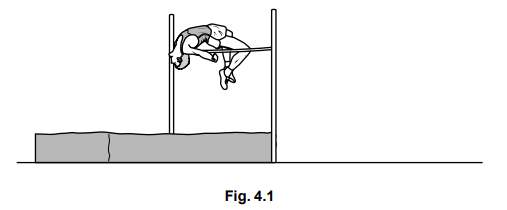Question
(a) State what is meant by the centre of mass of a body.
(b) Fig. 4.1 shows an athlete successfully performing a high jump.

The height of the bar above the ground is 2.0 m. The maximum increase in gravitational potential energy (g.p.e.) of the athlete during the jump is calculated using the expression
g.p.e. = mgh.
Explain why the value of h used in the calculation is much less than 2.0 m.
(c) Fig. 4.2 shows, in order, five stages of an athlete successfully performing a pole-vault.

Describe the energy changes which take place during the performance of the pole- vault, from the original stationary position of the pole-vaulter before the run-up, to the final stationary position after the vault.
Answer/Explanation
Answer:
(a) (The point in the body) where (all) the mass / weight / gravity acts / appears to act (owtte)
(b) h is the height through which the centre of mass/rises
OR centre of mass/rises (much) less than 2.0 m
OR centre of mass/of athlete is above the ground level
OR centre of mass/gravity passes under bar
Allow centre of gravity in place of centre of mass
(c) Standing: has chemical energy
Run-up: kinetic energy gained
Pole bent: has strain / elastic energy
Rise: potential energy gained
Fall: kinetic energy gained
On mat: has thermal / heat / sound / strain / elastic energy
